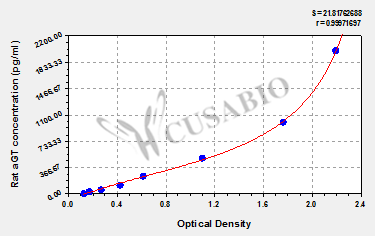This Rat angiotensinogen (aGT) ELISA Kit is designed to measure the levels of Angiotensinogen, also known as Serpin A8, in samples from Rattus norvegicus (Rat). This quantitative assay uses a sandwich ELISA method, providing reliable and accurate measurements of aGT in serum, plasma, and tissue homogenates.
With a detection range of 31.25 pg/mL to 2000 pg/mL and a sensitivity of 7.81 pg/mL, this kit enables precise and accurate measurements of aGT levels in rat samples. The assay time ranges from 1 to 5 hours, requiring only 50-100ul of sample volume. The detection wavelength is at 450 nm.
This Rat angiotensinogen (aGT) ELISA Kit is ideal for researchers in the cardiovascular research area, looking to study the role of aGT in the regulation of blood pressure, fluid and electrolyte balance, and renal function. The kit provides an efficient, accurate, and reproducible method for the detection and measurement of aGT levels in rat samples. Additionally, this kit has been cited in 3 publications, which demonstrates its reliability and usefulness in the field.




